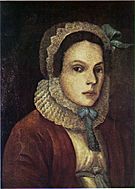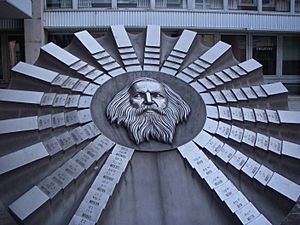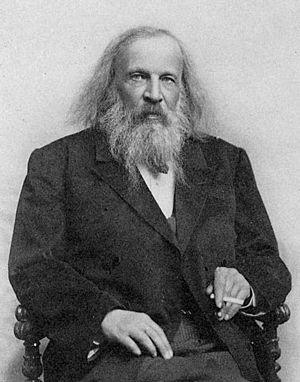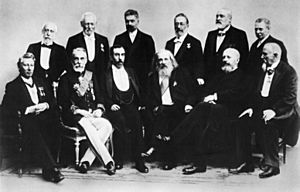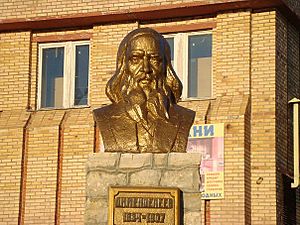Dmitri Mendeleev facts for kids
Quick facts for kids
Dmitri Mendeleev
|
|
|---|---|
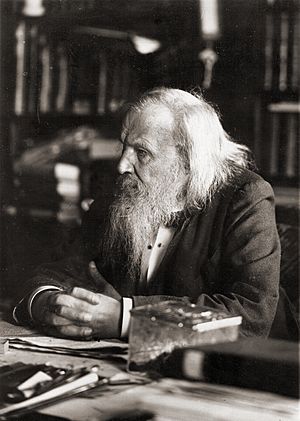
Mendeleev in 1897
|
|
| Born |
Dmitri Ivanovich Mendeleev
8 February 1834 Verkhnie Aremzyani, Tobolsk Governorate, Russian Empire
|
| Died | 2 February 1907 (aged 72) Saint Petersburg, Russian Empire
|
| Alma mater | Saint Petersburg University |
| Known for | Formulating the periodic table of chemical elements |
| Spouse(s) |
Feozva Nikitichna Leshcheva
(m. 1862; div. 1882)Anna Ivanovna Popova
(m. 1882) |
| Awards |
|
| Scientific career | |
| Fields | |
| Academic advisors | Gustav Kirchhoff |
| Signature | |
 |
|
Dmitri Ivanovich Mendeleev (born February 8, 1834 – died February 2, 1907) was a brilliant Russian chemist and inventor. He is famous for creating the first version of the periodic table of chemical elements. This table helps us understand how all the different elements in the universe are related. Because of his amazing work, he is often called the "Father of the Periodic Table."
Contents
Early Life and Education
Dmitri Mendeleev was born in Siberia, a large region in Russia. His father, Ivan Pavlovich Mendeleev, was a school principal. His mother, Maria Dmitrievna Mendeleeva, came from a family of merchants.
When Dmitri was young, his father became blind and lost his job. This meant his mother had to work hard to support the family. In 1849, his mother took Dmitri on a long journey across Russia. She wanted him to go to Moscow University, but he was not accepted there.
So, they traveled to Saint Petersburg, where his father had studied. Dmitri was able to join the Main Pedagogical Institute in 1850. After he graduated, he got sick with tuberculosis. To get better, he moved to the sunny Crimean Peninsula in 1855. There, he taught science at a school. By 1857, he was healthy again and returned to Saint Petersburg.
Between 1859 and 1861, Dmitri studied liquids and how light works with a tool called a spectroscope. In 1861, he wrote a textbook called Organic Chemistry. This book was so good that it won him a special award called the Demidov Prize.
Mendeleev became a professor at two important universities in Saint Petersburg. He started teaching inorganic chemistry in 1867. By 1871, he had made Saint Petersburg a famous place for chemistry research.
Creating the Periodic Table
In 1863, scientists knew about 56 different elements. About one new element was being found each year.
As a teacher, Mendeleev wrote a very important textbook called Principles of Chemistry. He wrote it between 1868 and 1870. While writing this book, he made his biggest discovery. He realized there was a pattern to the elements.
He didn't know about other scientists who were also working on similar ideas. Mendeleev started arranging elements based on their atomic weight and how they behaved chemically. He noticed that elements with similar properties appeared regularly. This repeating pattern is called "periodicity."
On March 6, 1869, he showed his new table to the Russian Chemical Society. His table organized elements by their atomic weight and their ability to combine with other elements (called valence).
Mendeleev's table had some key ideas:
- Elements show a repeating pattern of properties when arranged by their atomic weight.
- Elements with similar chemical properties either have similar atomic weights or their atomic weights increase in a regular way.
- The way elements are grouped in the table relates to how they react.
- Elements that are common tend to have small atomic weights.
- The atomic weight of an element helps decide what kind of element it is.
- He bravely predicted that many new elements would be discovered. For example, he predicted two elements similar to aluminum and silicon.
- He even suggested that the atomic weights of some known elements might need to be corrected.
Mendeleev's periodic table was amazing because it not only organized the known elements but also left spaces for and predicted the properties of elements that hadn't been discovered yet!
Later Life and Work
Mendeleev left Saint Petersburg University in 1890. In 1892, he became a Foreign Member of the Royal Society, a very respected scientific group. In 1893, he became the director of the Bureau of Weights and Measures. He held this important job until he passed away.
Beyond chemistry, Mendeleev was interested in many things. He studied population issues and supported research on the Arctic Ocean. He also worked to improve the use of chemical fertilizers. He was very active in helping Russia's petroleum industry grow.
Personal Life
Dmitri Mendeleev married Feozva Nikitichna Leshcheva in 1862. Later, he married Anna Ivanovna Popova in 1882. He had several children. His daughter Lyubov, from his second marriage, later married a famous Russian poet.
Death
Dmitri Mendeleev died in Saint Petersburg in 1907. He was 72 years old. He passed away from influenza.
Interesting Facts About Dmitri Mendeleev
- A synthetic chemical element, Mendelevium, with the symbol Md and atomic number 101, is named after him.
- A large crater on the far side of the Moon, called Mendeleev, is also named in his honor.
- In 1906 and 1907, he was nominated for the Nobel Prize in Chemistry for his discovery of the periodic system. However, he did not win.
- Mendeleev is also given credit for bringing the metric system to Russia.
- He studied how petroleum is made and helped start Russia's first oil refinery.
Commemoration
In Saint Petersburg, a special institute for precise measurements, the D. I. Mendeleev Institute for Metrology, is named after him. Next to it, there is a statue of him and a picture of his periodic table on a wall.
His former apartment at Saint Petersburg State University is now a museum. A street in front of the university is also named after him, called Mendeleevskaya liniya.
In Moscow, there is a university named after him: the D. Mendeleyev University of Chemical Technology of Russia.
Two minerals have been named in Mendeleev's honor: mendeleevite-Ce (named in 2010) and mendeleevite-Nd (named in 2015).
The Russian Academy of Sciences has given out a Mendeleev Golden Medal since 1965 to honor great scientific achievements.
On February 8, 2016, Google celebrated Dmitri Mendeleev’s 182nd Birthday with a special picture on their homepage called a "doodle."
See also
 In Spanish: Dmitri Mendeléyev para niños
In Spanish: Dmitri Mendeléyev para niños
- List of Russian chemists
- Mendeleev's predicted elements
- Periodic systems of small molecules


